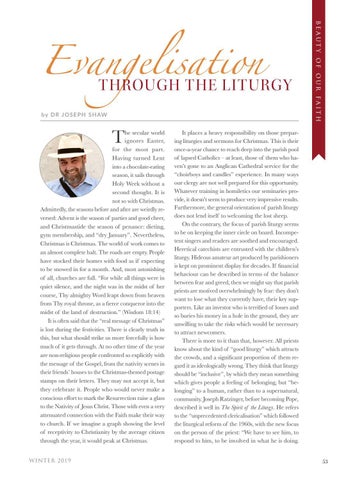b y D R J O S E P H S H AW
T
he secular world ignores Easter, for the most part. Having turned Lent into a chocolate-eating season, it sails through Holy Week without a second thought. It is not so with Christmas. Admittedly, the seasons before and after are weirdly reversed: Advent is the season of parties and good cheer, and Christmastide the season of penance: dieting, gym membership, and “dry January”. Nevertheless, Christmas is Christmas. The world of work comes to an almost complete halt. The roads are empty. People have stocked their homes with food as if expecting to be snowed in for a month. And, most astonishing of all, churches are full. “For while all things were in quiet silence, and the night was in the midst of her course, Thy almighty Word leapt down from heaven from Thy royal throne, as a fierce conqueror into the midst of the land of destruction.” (Wisdom 18:14) It is often said that the “real message of Christmas” is lost during the festivities. There is clearly truth in this, but what should strike us more forcefully is how much of it gets through. At no other time of the year are non-religious people confronted so explicitly with the message of the Gospel, from the nativity scenes in their friends’ houses to the Christmas-themed postage stamps on their letters. They may not accept it, but they celebrate it. People who would never make a conscious effort to mark the Resurrection raise a glass to the Nativity of Jesus Christ. Those with even a very attenuated connection with the Faith make their way to church. If we imagine a graph showing the level of receptivity to Christianity by the average citizen through the year, it would peak at Christmas. WI N T E R 2 0 1 9
beauty of our faith
THROUGH THE LITURGY
Evangelisation
It places a heavy responsibility on those preparing liturgies and sermons for Christmas. This is their once-a-year chance to reach deep into the parish pool of lapsed Catholics – at least, those of them who haven’t gone to an Anglican Cathedral service for the “choirboys and candles” experience. In many ways our clergy are not well prepared for this opportunity. Whatever training in homiletics our seminaries provide, it doesn’t seem to produce very impressive results. Furthermore, the general orientation of parish liturgy does not lend itself to welcoming the lost sheep. On the contrary, the focus of parish liturgy seems to be on keeping the inner circle on board. Incompetent singers and readers are soothed and encouraged. Heretical catechists are entrusted with the children’s liturgy. Hideous amateur art produced by parishioners is kept on prominent display for decades. If financial behaviour can be described in terms of the balance between fear and greed, then we might say that parish priests are motived overwhelmingly by fear: they don’t want to lose what they currently have, their key supporters. Like an investor who is terrified of losses and so buries his money in a hole in the ground, they are unwilling to take the risks which would be necessary to attract newcomers. There is more to it than that, however. All priests know about the kind of “good liturgy” which attracts the crowds, and a significant proportion of them regard it as ideologically wrong. They think that liturgy should be “inclusive”, by which they mean something which gives people a feeling of belonging, but “belonging” to a human, rather than to a supernatural, community. Joseph Ratzinger, before becoming Pope, described it well in The Spirit of the Liturgy. He refers to the “unprecedented clericalisation” which followed the liturgical reform of the 1960s, with the new focus on the person of the priest: “We have to see him, to respond to him, to be involved in what he is doing. 53











